Ad networks are crucial for publishers seeking to monetize their digital content. They act as intermediaries between publishers and advertisers, streamlining the process of selling ad space and maximizing revenue potential.
This carefully curated list of the top 7 ad networks in 2025 aims to help publishers decide which platforms best suit their needs, traffic levels, and monetization goals.
I have meticulously researched and analyzed various platforms, considering revenue potential, user experience, ad quality, and publisher support. So, let us start without any further ado!
Top 7 Ad Networks – Quick Overview (2025)
Let’s look at the top contenders in the ad network space. The following table provides a snapshot of the seven best ad networks, highlighting their key strengths and target audiences:
| Sr. No. | Ad Network | Key Strength |
|---|---|---|
| 1 | Google AdSense | Largest reach and brand recognition |
| 2 | Media.net | Contextual ads and Yahoo! Bing network |
| 3 | Amazon Publisher Services | Access to Amazon’s advertising ecosystem |
| 4 | AdMaven | Diverse ad formats and anti-adblock technology |
| 5 | PropellerAds | Push notifications and innovative formats |
| 6 | Adsterra | High CPMs and global coverage |
| 7 | SmartyAds | Header bidding and programmatic solutions |
7 Best Ad Networks In 2025: Detailed Review
In this section, I will help you explore each of these top ad networks, their key features, pricing models, requirements, and ideal use cases to help you determine which might be the best fit for your publishing needs.
1. Google AdSense
| Parameters | Details |
|---|---|
| Pricing model | Revenue share (68% for content ads) |
| Minimum traffic requirements | There is no strict minimum, but account approval is required |
| Ad formats supported | Display, in-feed, in-article, matched content, link units |
| Who it’s best for | Publishers of all sizes, especially those new to monetization |
Google AdSense remains the most widely used ad network globally. It offers unparalleled reach and access to a vast pool of advertisers.
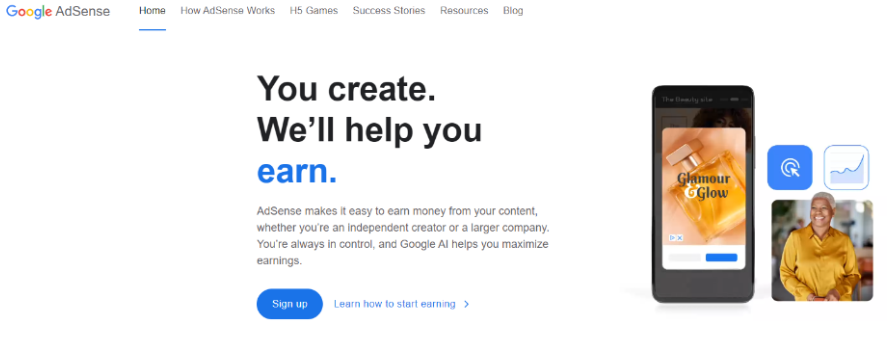
The platform is known for its ease of use, making it ideal for beginners while providing powerful optimization tools. AdSense’s contextual targeting ensures relevant ads are shown to visitors, potentially improving click-through rates and overall revenue.
Google AdSense Key features:
- Auto ads for easy implementation
- Robust reporting and performance analytics
- Strong brand safety measures
Google AdSense Pros:
- Easy to set up and use
- Large advertiser base
- Reliable payments
Google AdSense Cons:
- Can be competitive for high-paying niches
- Less control over ad content compared to direct sales
2. Media.net
| Parameters | Details |
|---|---|
| Pricing model | Revenue share (not publicly disclosed) |
| Minimum traffic requirements | There is no strict minimum, but high-quality traffic is preferred |
| Ad formats supported | Contextual ads, display, native, sticky ads |
| Who it’s best for | Publishers with primarily US, UK, and Canada traffic |
Media.net is powered by the Yahoo! Bing network, offering a solid alternative to AdSense. The platform specializes in contextual ads, delivering highly relevant advertisements based on your content. This can improve user experience and increase earnings for niche sites.
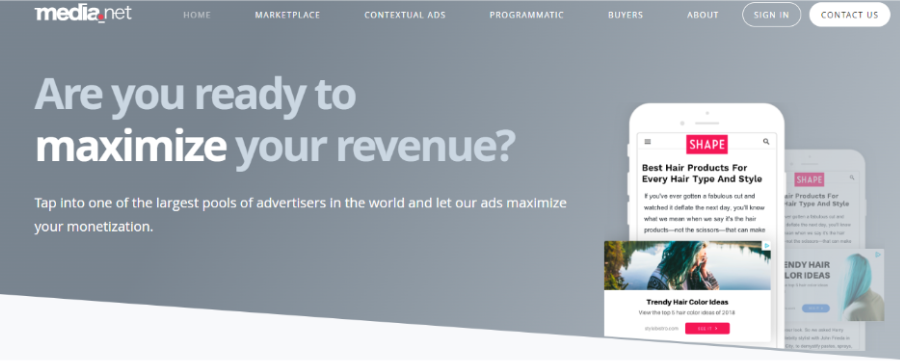
The platform’s dynamic optimization of ad units and access to premium advertisers can lead to competitive CPMs, especially in specific niches. While Media.net doesn’t publicly disclose its revenue share percentage, many publishers report earnings comparable to or exceeding those from AdSense in particular categories.
Media.net Key features:
- Dynamic optimization of ad units
- Access to premium advertisers
- Dedicated account management for larger publishers
Media.net Pros:
- Competitive CPMs, especially for specific niches
- Excellent contextual targeting
- Sleek, customizable ad designs
Media.net Cons:
- Best performance limited to specific geos
- Approval process can be stringent
3. Amazon Publisher Services
| Parameters | Details |
|---|---|
| Pricing model | Varies based on integration (header bidding, direct deals) |
| Minimum traffic requirements | Typically suited for larger publishers |
| Ad formats supported | Display, video, native |
| Who it’s best for | Mid to large-sized publishers seeking programmatic solutions |
Amazon Publisher Services (APS) provides publishers with direct access to Amazon’s vast advertising ecosystem. It offers header bidding solutions and cloud-based ad serving, allowing publishers to maximize their yield through increased competition for ad inventory.

Pricing models vary based on integration methods, such as header bidding or direct deals. While APS doesn’t publicly state minimum traffic requirements, its advanced features typically best suit larger publishers.
Amazon Publisher Services Key features:
- Transparent Marketplace for real-time bidding
- Integration with significant demand sources
- Advanced analytics and reporting
Amazon Publisher Services Pros:
- Access to Amazon’s high-value advertising demand
- Potential for higher CPMs through increased competition
- Server-side header bidding for improved page load times
Amazon Publisher Services Cons:
- Can be complex to implement for smaller publishers
- Best suited for sites with significant traffic
4. AdMaven
| Parameters | Details |
|---|---|
| Pricing model | CPM, CPC, CPA |
| Minimum traffic requirements | No strict minimum |
| Ad formats supported | Pop-unders, interstitials, push notifications, native ads |
| Who it’s best for | Publishers open to less traditional ad formats |
AdMaven offers diverse ad formats, including some that are considered more aggressive, like pop-unders. Their anti-adblock technology helps ensure ads are delivered even to users with adblockers installed, potentially increasing overall revenue. PushAd Networks also featured AdMaven as one of the best networks for push notifications and native ads.
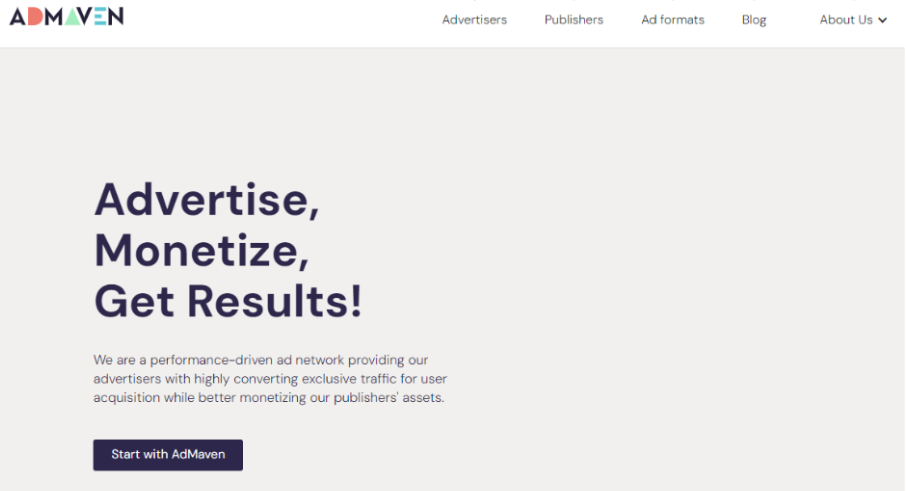
AdMaven’s real-time bidding platform and detailed targeting options can lead to high fill rates and potentially higher earnings, especially when utilizing their proprietary anti-adblock solution. However, publishers should carefully consider the impact of some ad formats on user experience.
AdMaven Key features:
- Real-time bidding platform
- Detailed targeting options
- Proprietary anti-adblock solution
AdMaven Pros:
- High fill rates
- Flexible payment options
- Potential for higher earnings with less traditional formats
AdMaven Cons:
- Some ad formats may impact user experience
- May not be suitable for all types of websites
5. PropellerAds
| Parameters | Details |
|---|---|
| Pricing model | CPM, CPC, CPA |
| Minimum traffic requirements | No strict minimum |
| Ad formats supported | Push notifications, popunders, interstitials, native banners |
| Who it’s best for | Publishers looking to diversify ad formats, especially with push notifications |
PropellerAds specializes in push notifications and other high-impact ad formats. It offers a self-serve platform that allows publishers to quickly implement and manage their ad inventory, focusing on maximizing engagement and revenue.
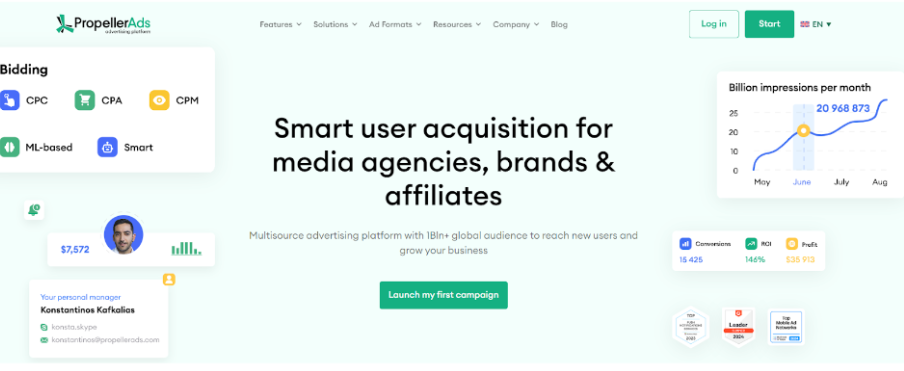
Pricing models include CPM, CPC, and CPA, catering to different publisher preferences. PropellerAds doesn’t impose strict traffic minimums, welcoming publishers of various sizes.
PropellerAds Key features:
- Advanced targeting capabilities
- Real-time statistics and reporting
- Proprietary anti-fraud system
PropellerAds Pros:
- Innovative ad formats can lead to higher engagement
- Global coverage with support for multiple languages
- Low minimum payout threshold
PropellerAds Cons:
- Push notifications may not be suitable for all website types
- Some formats may be considered intrusive by users.
6. Adsterra
| Parameters | Details |
|---|---|
| Pricing model | CPM, CPC, CPA |
| Minimum traffic requirements | No strict minimum |
| Ad formats supported | Popunders, social bar, native ads, banners, VAST video |
| Who it’s best for | Publishers seeking high CPMs and global monetization options |
Adsterra supports multiple ad formats and provides flexible integration options, making it suitable for various publishers. Pricing models include CPM, CPC, and CPA, with Adsterra often boasting high CPMs, especially for tier 2 and 3 countries.
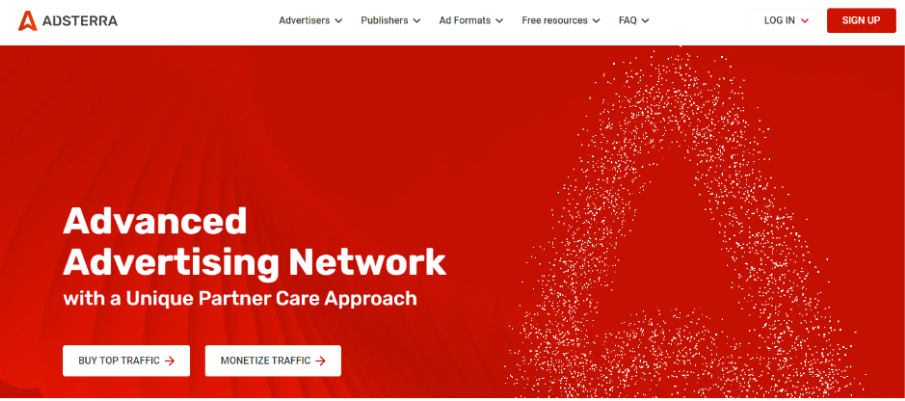
Adsterra’s wide range of supported ad formats, including popunders, social bars, native ads, banners, and VAST video, allows for versatile monetization strategies across different types of websites.
Adsterra Key features:
- Anti-malware scanning for all ads
- Multicurrency payouts
- Referral program for additional earnings
Adsterra Pros:
- High CPMs, especially for tier 2 and 3 countries
- Wide range of supported ad format
- Strong anti-fraud measures
Adsterra Cons:
- Dashboard can have a learning curve
- Some ad formats may not be suitable for all site types
7. SmartyAds
| Parameters | Details |
|---|---|
| Pricing model | CPM, CPC, CPA |
| Minimum traffic requirements | Typically suited for medium to large publishers |
| Ad formats supported | Display, video, native, rich media |
| Who it’s best for | Publishers looking for advanced programmatic solutions |
SmartyAds offers a full-stack programmatic advertising platform, including an SSP for publishers. They specialize in header bidding and other advanced yield optimization techniques to help publishers maximize their ad revenue.
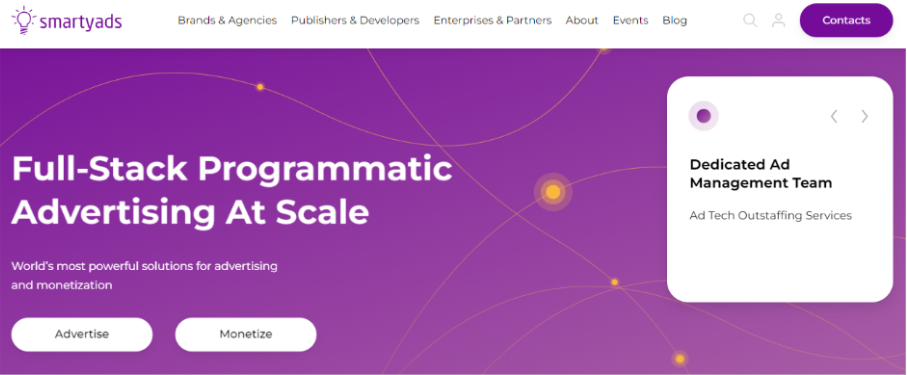
The platform supports CPM, CPC, and CPA pricing models, allowing for flexible monetization strategies.
SmartyAds Key features:
- White-label solutions available
- Cross-platform monetization (web, mobile, CTV)
- AI-powered yield optimization
SmartyAds Pros:
- Advanced programmatic capabilities
- Supports multiple ad formats across various platforms
- Transparent reporting and analytics
SmartyAds Cons:
- May be complex for smaller publishers
- Best results are typically seen with higher traffic volumes
How To Choose The Best Ad Network For Your Website?
When selecting an ad network, consider the following factors:
- Traffic volume and quality
- Geographic distribution of your audience
- Content niche and target audience
- Desired ad formats and their impact on user experience
- Technical capabilities and integration requirements
- Payment terms and minimum thresholds
- Quality of support and account management
To maximize ad revenue, here are a few tips that I follow:
1. Experiment with ad placements and formats
2. Continuously optimize for viewability and engagement
3. Use A/B testing to refine your ad strategy
4. Consider using multiple ad networks to increase competition
5. Monitor and improve your site’s loading speed
6. Focus on creating high-quality, engaging content
Related Reads:
Final Verdict: Google Adsense Is Free And My Top Pick!
While each ad network has strengths, Google AdSense remains the top pick for most publishers and me, especially for those just starting out. Its ease of use, vast advertiser network, and reliable payments make it an excellent choice for beginners and established sites.
However, your best ad network will depend on your circumstances. Larger publishers may benefit from the advanced capabilities of Amazon Publisher Services or SmartyAds.
Those looking to maximize revenue through diverse ad formats prefer PropellerAds or AdMaven. Media.net can be an excellent choice for publishers with primarily English-language content targeting US, UK, and Canadian audiences.
Ultimately, the key to success in ad monetization is experimentation and optimization. Don’t be afraid to try multiple networks and strategies to find what works best for your unique situation.
So, are you ready to start maximizing your ad revenue? Sign up for one of these top ad networks today and begin your journey to improved monetization!
FAQs
An ad network is a platform that connects publishers (website owners) with advertisers, facilitating the buying and selling of ad inventory across multiple websites.
Google AdSense is widely considered the most used ad network globally due to its ease of use and vast reach.
Google Ads (formerly AdWords) is the largest ad network in reach and market share, working in tandem with Google AdSense for publishers.
Google AdSense is often the best starting point for new websites due to its low entry barriers and ease of implementation.
The “best” ad company varies depending on a publisher’s needs, but Google consistently ranks highly due to its extensive reach and advanced technology. However, networks like Media.net, Amazon Publisher Services, and others may be preferable for certain publishers based on their specific requirements and audience characteristics.